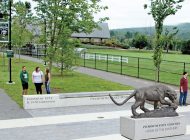
Cucina (in orange), students, and faculty in the health and human performance department had a ball promoting Project ACES (All Children Exercising Simultaneously) at PSU in May. Now in its 24th year, Project ACES is a worldwide annual event to promote physical activity for children. Kindra Clineff photo.
Professor Irene Cucina has been teaching in the Department of Health and Human Performance since 1998. Prior to coming to Plymouth State, she had a rewarding career as a high school health and physical education teacher and coach in Newton, MA. Her commitment to students and learning has been recognized by her peers through a number of awards including the PSU Distinguished Teaching Award in 2011 and the Massachusetts State High School Physical Education Teacher of the Year Award in 1996.
Her expertise and dedication to teaching health and physical fitness has been recognized with awards at all levels; most recently, she was elected the president of the American Alliance for Health, Physical Education, Recreation, and Dance (AAHPERD), the largest national association representing health and physical education professionals. Cucina, whose research interests include injury prevention, exercise in the treatment of diabetes, and obesity and childhood obesity prevention, is a much sought-after speaker who has presented at more than 95 conferences at the state, district, and national levels.
Recently, Plymouth Magazine spoke with Cucina about the importance of physical activity in childhood, and what she feels needs to be done to abate our country’s childhood obesity epidemic.
How did you become interested in health and physical education?
When I was in the 4th grade, my physical education teacher made me recognize that I was athletically skilled and with that knowledge my confidence soared. I quickly became what was known as a “gym rat” and spent as much time as possible in the gymnasium. This continued in junior high school and high school with the advantage of my becoming a physical education leader. The PE leaders assisted the physical education teachers during their classes. That’s when I fell in love with teaching. I became a swim instructor, coached youth sports, and worked with the Special Olympics. I decided the only career for me would be to teach health and physical education.
The statistics on childhood obesity, one of your research areas, are sobering. One estimate says that one in three children in the US is overweight or obese. What can be done about childhood obesity?
Childhood obesity is an epidemic. Data has been collected through the Centers for Disease Control on obesity trends for over 30 years. During that time, the childhood obesity rate has more than doubled for preschool children aged 2–5 and adolescents aged 12–19.
In the most recent issue of the journal The Lancet, researchers have reported that the problem is not about obesity but the lack of physical activity. In fact, according to one study, it was shown that physical inactivity kills more people than smoking.
I believe that government and private sectors need to work together to mandate and support daily physical education for every child in the US. Children need an hour of physical activity a day to achieve and maintain a healthy weight. Schools need to implement a comprehensive physical activity plan and hire qualified physical educators who can teach children the knowledge and skills they need to embrace a lifetime of physical activity. And schools and communities need to create physical activity-friendly environments where children and adults could get their 60 minutes of physical activity every day. If we all work together, we can make a real difference in this epidemic.
In my role as president of AAHPERD, I am working to promote the benefits of physical activity to administrators, parents, and other stakeholders. AAHPERD has launched a national initiative called Let’s Move In School in conjunction with First Lady Michelle Obama’s Let’s Move campaign. Schools that commit to increasing physical activity before, during, and after school through staff, family, and community involvement can provide a setting that allows and encourages children to get that recommended 60 minutes of physical activity every day.
As a professor of health and physical education, you are teaching the next generation of educators. What are the most important things you want your students to come away with as they embark on their own careers in health and physical education?
I emphasize to all of my students that the future is in their hands. They will be teaching a generation of children that researchers predict will not survive their parents. They must continue to emphasize the importance of physical activity for health and wellness. It is their duty as future teachers to be role models who demonstrate the benefits of movement by practicing what they preach.
My students’ energy, commitment, and enthusiasm for teaching children and young adults gives me the confidence that, over next decade, we can reduce childhood obesity rates, and help children lead healthier and more active lives.
Tags: AAHPERD childhood obesity Faculty Forum health and human performance Irene Cucina









